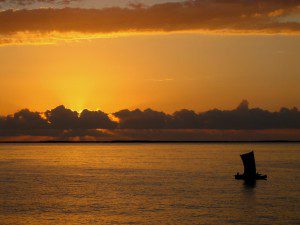The livelihood of the local Vezo people is completely dependent on the sea. This is, after all, why we are here: we are providing the science to help the Vezo understand how make the most of what their sea has to offer. But life with the sea can be far from simple, as we found first hand on our first day of this expedition.
The whole group arranged for sailing pirogues to take us to the nearby island of Nosy Hao. It seemed a gorgeous day for a sail and snorkel, with a picnic lunch prepared by the expedition kitchen to top it off. For the eleven of us, we found four pirogues, each with a crew of three, to depart mid-morning for our excursion. I rode in the pirogue led by the most experienced captain, one who clearly enjoyed not only sailing well, but racing hard. His crew quickly unfurled the huge sail, leading us to an early start, and throughout the half-hour journey, he was alternately fiddling with the rigging and pumping his fist in the air, shouting with glee as the wind whipped our hair, the sea sped beneath us, and the space between us and the boats behind grew and grew. The crew, like we, were full of delight for such a perfect day to sail.
We had a good couple of hours on the island, taking time to snorkel the reef flat (enjoyable but for the many jellyfish near the surface that day) and to enjoy our packed lunch of rice and fish. While we were swimming and eating, we didn’t notice the slow but dramatic turn the day’s weather was taking, and it was only after the wind started to gust after lunch that we noticed the approaching storm. The sky had turned completely gray, the wind had begun to whip the waves of the sea into a gentle froth, and rain was visible from the bases of the clouds in all directions, growing ever closer. We knew the inevitable downpour would not be far off.
The experienced boat crews found the first shelter as the skies opened, crouching in the beached pirogues and wrapping themselves in the sails. Several of us tried to use one of the sails as a massive tarpaulin, an attempt made futile as the sail grew heavier from the absorbed rain and whipped against our backs ever more violently with the increasing wind. The clever ones among our group realized that the air had cooled below the water temperature and swam back out to keep warm while the rest of us were made equally wet from the heavy rain.
After a bone-drenching five minutes, the rain began to subside, and everyone jumped into action to prepare for our return, despite the persistent wind. Within moments, our picnic was fully packed, the boats were back in the now-rough water, the sails were aloft, and we had clambered back into the boats for the return trip. Gone was the care-free shouting of the earlier race as the crew focused their entire attention on keeping the boat upright as we faced the stiff wind and tall swells to sail back. The small flag at the front of the boat used to measure the wind was chattering mightily as it fluttered, standing erect in the wind, as the waterlogged sail was drooping into the crests of the passing waves. One of the crew, sitting out on the balance pole, leaning against the rigging rope, would ride high into the air with every passing wave, and then drop back down as the boat rode down the back of each crest, drenching us with spray as it fell back against the water. It seemed a miracle that he didn’t fall from the pole as he went up and down while the boat listed from side to side. Our captain again fiddled with the rigging throughout the trip as he sat tall and alert, focused on the sea ahead as if waiting to be attacked at any moment, while another of the crew worked to bail out all of the water we were taking on with every passing swell.
Our return trip was finally successful and surely shorter than the first sailing even if it seemed longer due to the tense air and the continual drenching. One of the boats suffered a cracked mast under the force of the heavy sail against the wind, though that crew was quickly able to lash the sail well enough to keep the boat moving. Our crew was so sure of themselves that we never felt in any real danger despite the threatening conditions. After all, this was just another day at sea for the Vezo, who are out nearly every day, rain or shine, calm or storm, working hard as they try to catch what they can. Their livelihood depends entirely on what they can catch from the sea, and they toil endlessly to make the most of it. Watching them makes me hopeful that our conservation effort is successful, helping them to fish more sustainably and remain in balance with life in the sea. As we saw that day, living with the sea is already hard enough without having to worry about whether it will die out.



You are doing a Great job by educating the Vezo because their life depends entirely on sea only.
At least they should have primary knowledge about how the sea would behave.
Carry on your Good work.
Thank you.
Regards,
Mike.